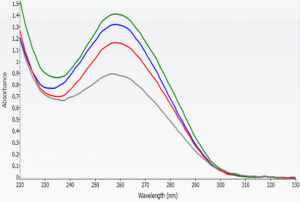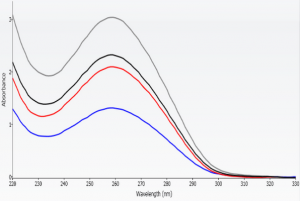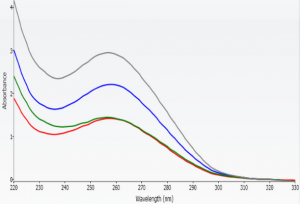Consistent high-quality DNA purification from human and animal blood (whole, dried, clotted, frozen), cells (cultured, WBCs, PBMCs), swabs, sputum, urine and stool
Performance specifications
| Sample | Sample amount | DNA yield (µg) | 260/280 ratio |
|---|---|---|---|
| Whole blood | 200 µl | 3-12 | 1.7-2.0 |
| Clotted blood | 100 µl | 6-12 | 1.9-2.0 |
| Dried blood | 200 µl | 1.6-1.9 | 1.6-1.9 |
| Cells (WBCs) | 106-107 cells | 2-11 | 1.7-1.9 |
| Swab | 1 swab | 2-10 | 1.7-2.0 |
| Sputum | 100-200 µl | 6-18 | 1.7-1.9 |
| Urine | 5-10ml | 1-3 | 1.6-1.9 |
| Stool | 100-200 mg | 3-16 | 1.6-1.9 |
Faster, easier, low-cost DNA extraction
- One kit for a variety of human and animal samples
- Validated for most clinical samples including aspirates, lavages and effusions
- Fastest and easiest protocol for samples like sputum and stool
- Low-cost, high quality DNA for molecular biology use
- Rapid proteinase K digestion for high quality DNA
Buy Swagene Blood DNA Extraction kit
Kit downloads
Protocols and examples of DNA isolated from various samples
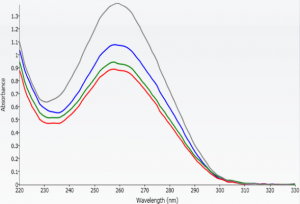 Sample preparation for DNA extraction from blood (whole, dried, clotted, frozen)
Sample preparation for DNA extraction from blood (whole, dried, clotted, frozen)
Blood collected in EDTA, heparin or citrate can be used. Yield and quality of DNA may decrease with prolonged storage. Before starting the isolation, mix blood to ensure the cells are in suspension.
Use 200 µl of blood (whole or frozen) as sample; use clotted blood roughly equivalent to 200 µl volume as sample.
To the right is a graph showing DNA extraction from 4 different samples of human blood (whole) using Swagene Blood DNA kit and measured by a nanospectrophotometer.
Sample preparation for DNA extraction from cells (cultured, WBCs, PBMCs)
Cultured cells: Cultured cells can be harvested by centrifugation or trypsin treatment, washed with PBS (phosphate-buffered saline), and the pellet used as sample.
Lymphocytes, WBCs or PBMCs (peripheral blood mononuclear cells): Cells obtained following use of Ficoll or similar reagents, or RBC lysis, from 500 µl to 5 ml of blood can be used.
To the right is a graph showing DNA extraction from 4 different samples of human white blood cells Swagene Blood DNA kit and measured by a nanospectrophotometer.
Sample preparation for DNA extraction from body fluids
Depending on the sample source, cell content of the sample, amount of sample and its integrity, choose one of these:
- Samples with high cell content, such as bone marrow aspirate: follow the blood protocol.
- Samples with low cell content: follow the plasma protocol.
- Samples with high volume: centrifuge and use the cell pellet as sample, and follow the cells protocol.
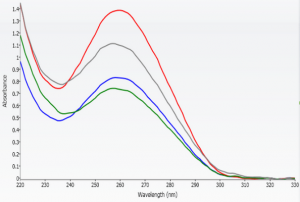 To the right is a graph showing DNA extraction from 4 different samples of human swabs using Swagene Blood DNA kit and measured by a nanospectrophotometer.
To the right is a graph showing DNA extraction from 4 different samples of human swabs using Swagene Blood DNA kit and measured by a nanospectrophotometer.
Sample preparation for DNA extraction from sputum
Sputum may be used after autoclaving, liquefaction and/or disinfection with sodium hydroxide, N-acetylcysteine and/or isopropanol. Use 200 µl of liquefied/autoclaved sputum, or the pellet after centrifuging 500 µl – 1 ml of sputum.
To the right is a graph showing DNA extraction from 4 different samples of human sputum using Swagene Blood DNA kit and measured by a nanospectrophotometer.
Sample preparation for DNA extraction from stool
Use 100-200 mg of fresh or frozen stool samples.
To the right is a graph showing DNA extraction from 4 different samples of human stool using Swagene Blood DNA kit and measured by a nanospectrophotometer.
Sample preparation for DNA extraction from urine
Centrifuge 6-10 ml of urine at 600 x g (~3,000 rpm) for 15 minutes. Use the cell pellet as sample.
Downstream applications
High yield and quality of DNA or RNA enable use in several specialized downstream applications
- PCR: conventional PCR, real-time PCR, digital PCR
- Gel electrophoresis and Southern blotting
- Restriction enzyme digestion
- Microarrays
- Sequencing: Sanger, NGS (next generation sequencing)
Kit Contents (50 isolations)
- Lysis Buffer (LD-B)
- Wash Buffer, concentrate* (WD)
- Elution Buffer (ED)
- Proteinase K
- Proteinase buffer
- DNA spin Columns
- Collection Tubes
- Abridged user manual
* Before use, add 100% ethanol to the concentrated wash buffer to make working WD as specified on the bottle

